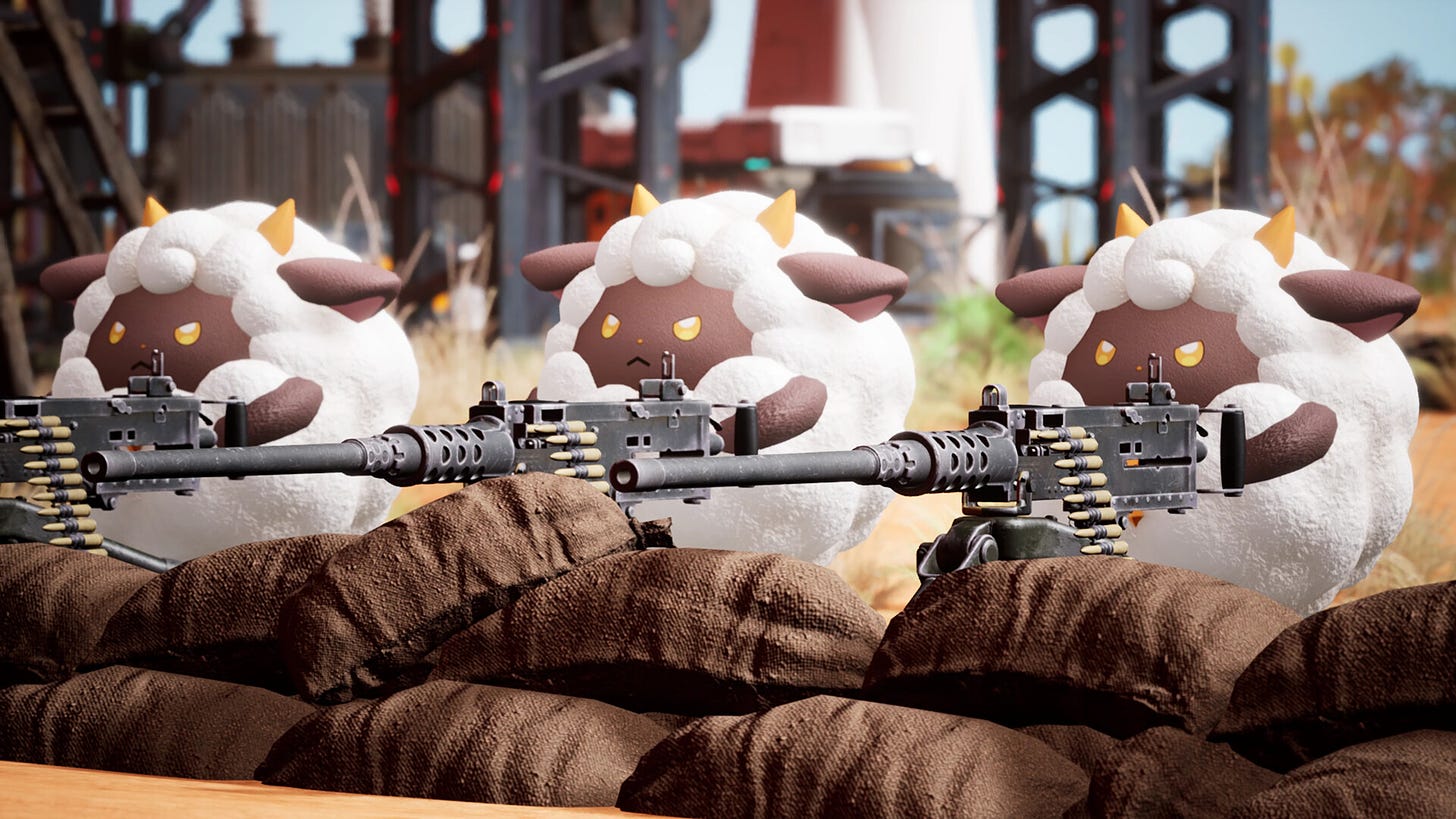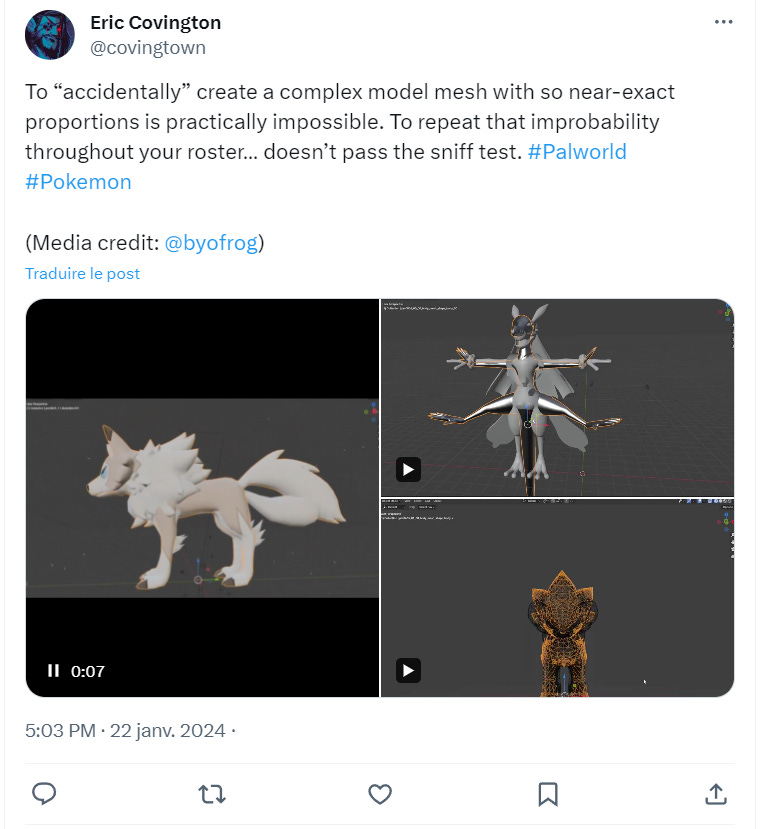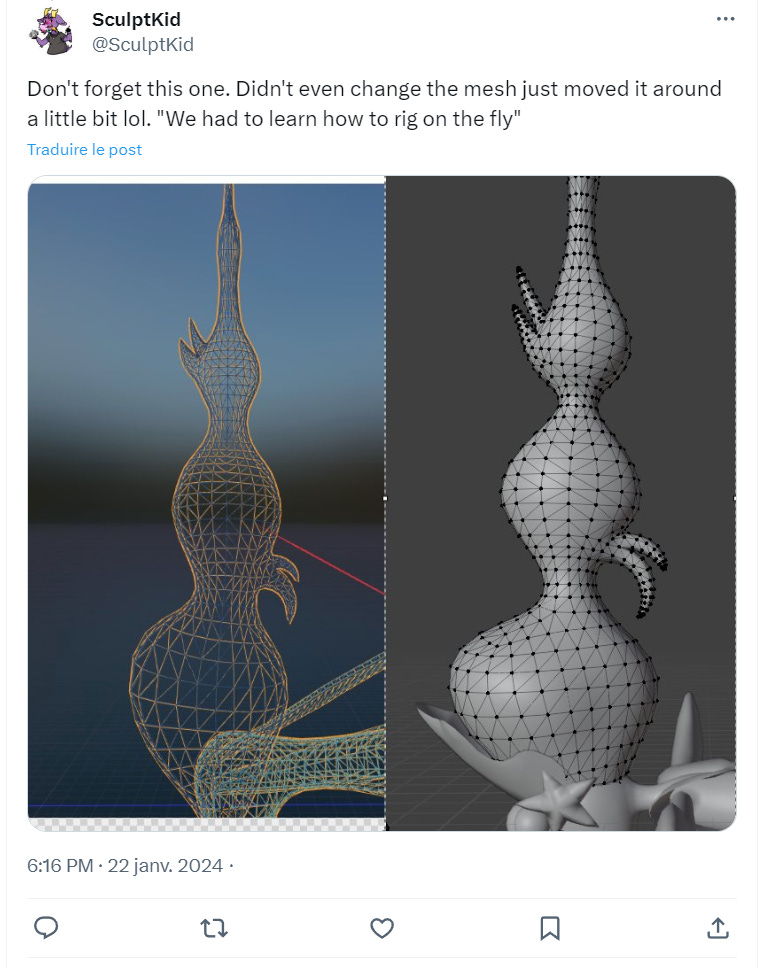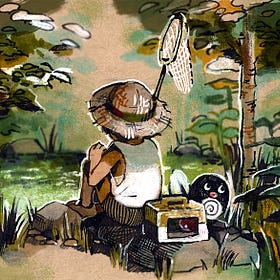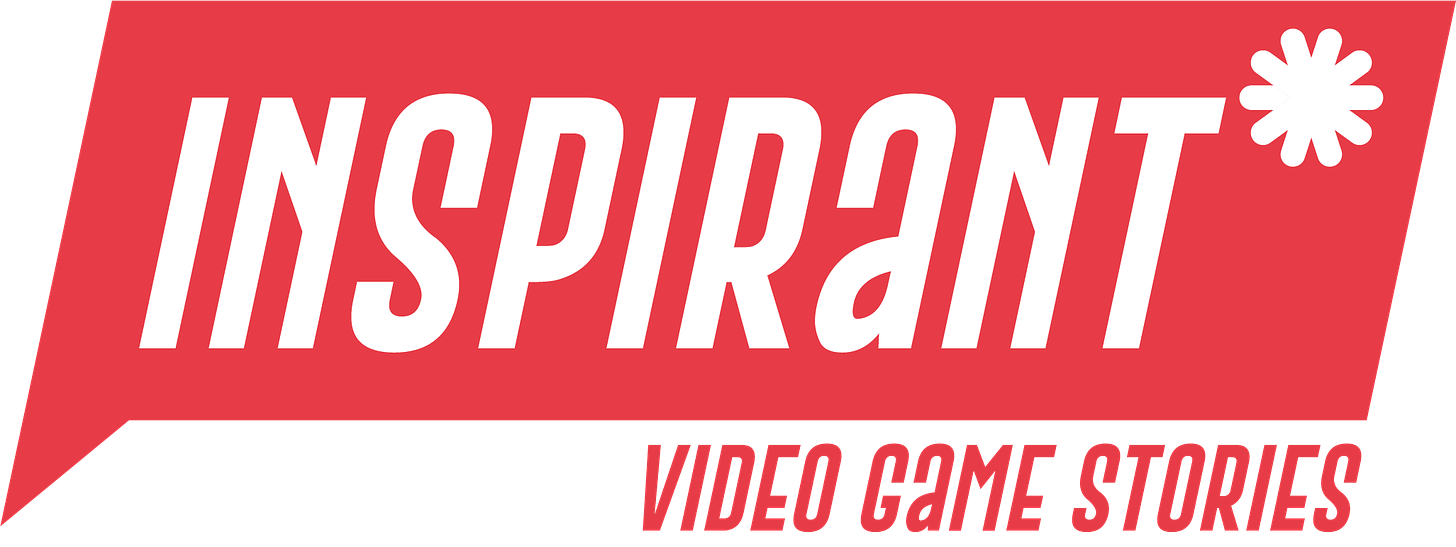Palworld: Success and Dispair
The new game from Japanese studio Pocket Pair has been a huge hit since its release on Steam. But there is currently much consternation among the industry's artists and developers.
There's no way you haven't heard about this game yet, it is trending everywhere. Palworld sold over eight million copies in only six days after its early access release on Steam on January 19, 2024, not even counting sales and downloads on the Windows and Xbox stores on which the game is also available. It had long been awaited by many gamers since it was first announced in 2021. At one point it has been more popular than Fortnite on Xbox, has reached the popularity of League of Legends, GTA V or Counter-Strike on Twitch and has become the second game on the Steam platform to have gathered the most players simultaneously: 2 million, behind PUBG: Battlegrounds but ahead of CS:GO.
So, what’s Palworld? This game is an action-adventure survival game from Japanese developer Pocket Pair, a young studio headed by Takuro Mizobe. The game takes place in an open world populated by Pokémon-like creatures known as "Pals". The game's premise, involving the use of firearms and the equipping of Pals with these weapons, earned it the nickname "Pokémon with guns". Other elements, such as using creatures for food or making them work in mines and factories, also attracted attention and some criticism. But overall, Palworld was very well received by the gaming community, garnering 94% positive ratings on Steam.
A controversial hit
Despite its instant success and high praise, the game has been the subject of much controversy since its announcement two years ago, and this has multiplied since its release. Why?
Well, in addition to highlighting the violence of the game (it had to go from PEGI 7 to 12 after its release) and accusations of slavery and animal abuse, many people have pointed out the obvious resemblance between the creatures in Palword and Nintendo's Pokémon. Pocket Pair has been accused of plagiarizing video games' most famous franchise, notably by basing their creatures on existing Pokémon 3D models, although producer Takuro Mizobe refutes these claims.
While the gameplay is mainly inspired by Ark: Survival Evolved (2015) and the artistic direction of the environment is quite different from Pokémon, it's the fact that the creatures in the two games look so much alike that is eye-catching and problematic. Some people would say the Pokémon from the very first games were heavily similar to those in Dragon Quest but still.
Unequivocal comparisons have been made by Internet users
Internet users have compared the 3D models of Pokémon creatures with those of Palworld, and there are many similarities. According to them, the Pocket Pair team extracted or recovered Game Freak models from the web in order to at least study them. We don't know how they went about creating the 3D models of the Pals, but the similarities in typology make us want to ask a few questions.
It's all supposition, there's nothing officially proven, but how could a 3D artist create such similar models without copying Pokémon ones? Some people also recognised the Pals' "inspirations", which are sometimes just mixtures of parts of existing Pokémon models.
A lack of experience
Could it be a lack of experience that explains this copying method? It's happened before, but rarely for such a popular game.
On the basis of a note from a Pocket Pair employee, we learn that:
this was the first time the studio had created its own 3D models, instead of buying everything as they had done for their previous projects
they didn't use source control or naming conventions
they learned what a rig was and how to make one "on the fly"
there was only one animator, a young man of 20 whose project was his first experience of the project. It's worth noting all the hard work he had to put in
CEO Mizobe had to help optimise the game himself shortly before its release, without any prior experience of the Unreal Engine
The whole team learned throughout the project, as everyone does.
Nevertheless, there is a noticeable lack of coherence in the overall artistic direction of the game: a semi-realistic environment, realistic weapons, ultra-cartoonish Pals and humans characters halfway between the environment and the creatures. Actually, they probably used the Pokémon’s look to generate hype and attract players, and it worked.
So what’s wrong?
Pokémon doesn’t own the Monster Catching genre, there are plenty of games that are available on the market like Tem Tem, Digimon or Yo-Kai Watch. The gameplay and the story are also very different. What bothers artists and game developers are Mizobe's working methods and the disdainful reactions of the players. These methods are not acceptable and encourage abuse in the industry.
The success of Palworld devalues artists' work
As we have seen, the Pokémon 3D models might have been directly used to model the Palworld creatures. It's almost humanly impossible to create such identical meshes without at least copying. Worse still, some Pals are concocted creations, with parts of this or that Pokémon simply put together. All the design work and thinking that the Game Freak artists put into their creatures has not been done here. Pocket Pair took this without giving it a thought, this could be defined as stealing, it's the same as what generative AIs do.
This is what is not acceptable for creatives. Greedy executives with dehumanising methods want products to be made quickly and without creativity, especially at a time of profound change in the industry. People are concerned about lay-offs and the use of AI, the game industry must shift towards a more humane model.
A very obscure CEO
The boss of Pocket Pair is one of those bosses. Takuro Mizobe is a Indeed, obscurity reigns around Takuro Mizobe and his studio. He his a fan of AI and cryptocurrencies, and his Pocket Pair studio seems to specialise in copies of popular titles such as Craftopia (often compared to Zelda: Breath of the Wild). In 2022, they released AI: Art Impostor, which uses generative-AI to power a party game. He doesn't come from the video game field and, prior to Pocket Pair, only took part in a seminar organised by Nintendo in 2010 around its console, the DS.
He later became an executive at a cryptocurrency company, Coincheck, which lost €430 million after a cyber-attack, a total that has since been reimbursed to clients. Then he became chief engineer at Spindle, another cryptocurrency company that was known to have raised the largest fund in cryptoassets in Japan's history but had to move to London in a hurry because of a financial services investigation against them.
After he made his fortune, he invested his money in his studio: the budget for Palworld is estimated at around $7 million. In addition, his love for cryptocurrencies is fuelling rumours that NFTs will be added to the game.
Gamers: soulless consumers?
Unfortunately, the boss of Pocket Pair isn't the only one who doesn't care about game artists - gamers are too… Gamers really are consumers. They can be cruel and indifferent when it comes to the artists, but also to all the other people who work on their favourite games. On social networks, many people in the games industry have complained about Palworld's production methods. The response from gamers and certain streamers, mainly on Twitter, YouTube and Twitch, has been extremely virulent.
As I have read, many gamers have said that they don't care about the conditions in which Palworld is produced because playing it is fun. They don't care about the fate of the artists, just as they don't care when animation or video studios use artificial intelligence in their 'creations'. They don't see the issue in re-using Pokémon assets because Pokémon is a huge company that makes billions every year. They support the little David against the Goliath, and some go so far as to describe Pocket Pair as a studio full of passionate people united against multinational that is only concerned with making money. It’s well deserved for Nintendo, isn’t it?
In fact, it's important to understand that gamers are consumers. They're only interested in the final product that's presented to them. It has to look good and be fun, no matter how it's made. What's more, they want their money's worth, fun content. Above all, it's a lack of knowledge of the industry that generates such virulent reactions towards those who work in it. The same goes for many other sectors: food, electronics, fashion, cosmetics and so many others. As long as it's cheap and at least a little good-looking, consumers rush to buy it, without worrying about the conditions in which it's made…
Video game creators need empathy and support these days, and gamers need to realise this! Without all the people who work in this creative industry, all professions included, how will these gamers be able to get their new skins and updates on their favourite games? This is causing great despair among many of the industry's peers, especially at a time of increasing use of artificial intelligence and lay-offs (>5,600 in January 2024 alone, around 60% more than in the whole of the previous year).
People are, and must remain, at the heart of video game creation. There is a clear risk that studios with questionable methods will spread.
An investigation opened at Nintendo
A few days after the launch of the early access game, a video of a mod using real Pokémon appeared on social networks. The creator promised players that they would be able to replace Pals with Pokémon and change the player's appearance to Ash Ketchum. Nintendo, the publisher of the Pokémon saga, by asking the modder to remove the video and to refrain from publishing the mod or face criminal prosecution.
Nintendo has finally reacted officially in a press release on Thursday 25 January 2024 regarding Palworld. They explain that they have received numerous requests concerning the resemblance between Pals and Pokémon creatures and have announced that they are opening an investigation into the matter. But there's not much in the way of legal action for Nintendo, the Pals aren't exact copies and their names are all different. Only the Paldex, the object used to track the Pals, and the Pal Sphere, are inevitably reminiscent of Pokémon's Pokédex and Poké-Ball.
Mizobe even claims to have taken the necessary legal precautions to protect itself, in an exchange with the Japanese specialist website Automaton, quoted in an article published on 19 January. Mizobe puts a lot of effort into defending his studio: "We make our games very seriously and we have absolutely no intention of infringing upon the intellectual property of other companies".
But this is not enough to extinguish criticism.
There's a good chance that Palworld will fade into oblivion after a brief moment of brilliance (Among Us, Fall Guys, etc.) like so many games before it. They definitely can’t replace something as big as Pokémon. Ten days after launch, the number of players is already slowly starting to drop, although Pocket Pair is announcing updates and new Pals to catch. Has the trend disappeared already?
Mizobe won't be sad: Pocket Pair achieved sales of over 100 million dollars for a game with a budget of 7 million dollars.
Let's hope that this event wakes up Nintendo and The Pokémon Company to make Pokémon games that are technically and graphically worthy of their rank. Perhaps they need to space out the release of new titles a little more, or beef up the Game Freak team, whose numbers haven't increased for many years. The success of Palworld is a strong message for Nintendo, with sales figures after one week that exceed those of Pokémon Legends: Arceus (6.5 million) and almost reaching those of Pokémon Scarlet and Violet (10 million). Is it a lack of daring on the part of The Pokémon Company that has led players towards Palworld?
Related Inspirant: Video Games Stories posts:
The creation of Pokémon
If you liked this article and want to support me, you can buy me a coffee on Ko-fi. This would help me continue writing this newsletter and would be very much appreciated. Thank you! ☕




